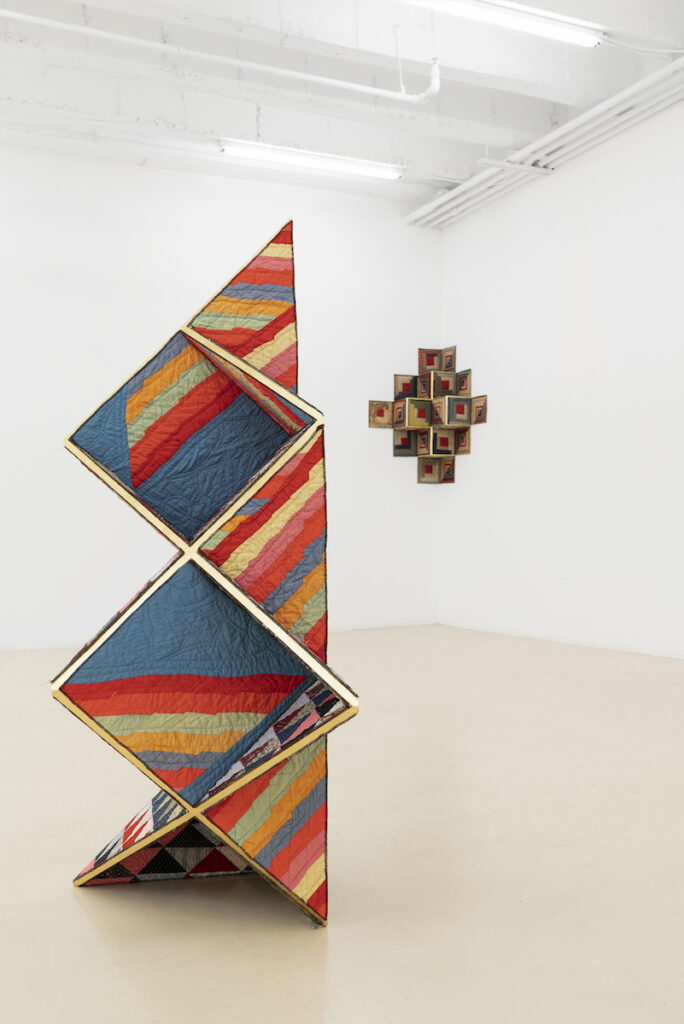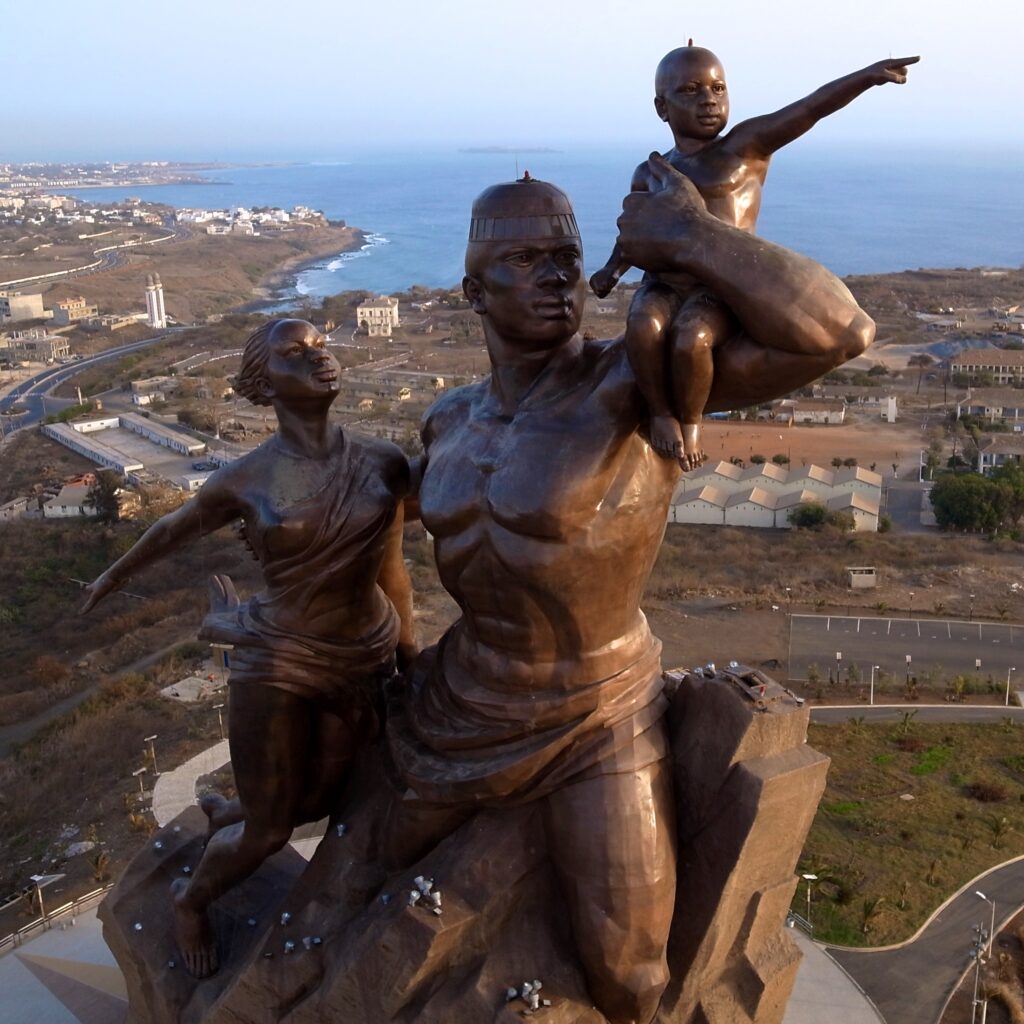| Published on June 23, 2022 |
A review of Sandford Biggers’ Oracle
By: Ife Olusegun
About the artist
Sanford Biggers is a Los Angeles-born Black American artist whose main media of work includes film, video, sculptures, and performances. He has recently created a statue that has been revealed at the Rockefeller Centre in New York, U.S. This statue, titled Oracle, is the biggest piece of his work to this day. Biggers’ work has been featured in various recognizable museums and art galleries before this feature, including the Contemporary Art Museum in St. Louis Missouri, the Marianne Boesky Gallery in New York, and the Sculpture Centre in Long Island City, New York. The picture below shows an art installment of one of Biggers’ art pieces at the David Castillo Gallery in Miami, Florida.
Despite all of these museum features, the Rockefeller Centre feature gives him a different type of spotlight, and far more intense exposure. Here’s why.

The Rockefeller Centre and family
In 1931, commissioned by the Rockefeller family, the construction of the Rockefeller Centrebegan. It was originally deemed as the land for a new Metropolitan Opera building, but when the Met discovered that they could not afford to continue with construction, the planning and execution of the Rockefeller Centre began. The Rockefeller family is one of the richest family dynasties in the world. They are so wealthy that their net worth is not known to researchers. This family founded and ran the largest oil refiner company in the world back in 1870: Standard Oil. They were considered one of the most powerful families throughout North American history.
With wealth, power and strength, comes controversy, questionable politics, and family secrets. One of the Rockefeller sons, Micheal Rockefeller, was presumed to have been eaten by cannibals—people who feed on human flesh—while trying to steal artifacts and artwork from an expedition through Indonesia. It was common for the Rockefellers to claim the right to the artwork that was not their own, not only in Indonesia but in some of the countries in Africa as well.
After Standard Oil was disbanded in 1911, the family legacy was concentrated on the construction and elaborate building of the Rockefeller Centre. Consisting of various commercial buildings, and having been named a National Historic Landmark in the 1980s, it is correct to think that the Rockefeller Centre holds monumental art pieces and statues. Some famous art pieces that are featured in the Centre include the ancient Greek Atlas, the Greek legend of the Titan Prometheus, the Greek God Zeus carved into the sculpture titled Wisdom and now, Oracle by Sanford Biggers

About Oracle
How did the statue of Oracle come about? Biggers has an ongoing theme of art sculptures that he titles “The Chimera Series” consisting of pieces that combine African masks with European figures in an attempt to explore the historical portrayal of the body, myths and power. In his artist statement, Biggers mentions that Oracle was inspired by “African culture”—however, there are only two cultures from Africa related to Oracle. The body of Oracle is supposed to represent the body of a seated Olympian Zeus with a chimera head from two relatively random African cultures: the Maasai people and the Luba people. On top of Zeus’ body, Oracle has the face of a Luba Hemba Fertility figure, and the hair of a Maasai warrior. In addition, there is an interactive element of Oracle. With the simple scan of a QR code, anyone that visits the sculpture will be able to speak to Oracle and receive direct responses about their future, like how one would go see a palm reader or a fortune teller. The presence of this feature in conjunction with Oracle can be quite unsettling for some
These two cultures—Maasai and Luba—do not represent all of Africa. It only reinforces the Western world view of all Africans being idol worshippers or fearsome hunters. This is far from the truth because one of the Maasai tribes does not even worship idols. They are monotheistic people and the form of God in their religion exists through nature. For example, healing, wind and thunder are all parts of who they believe God to be. In fact, one of the first Christian kingdoms, a monotheistic religion, was established in Africa. The vast number of cultures that exist in Africa cannot be summarized and lumped into the phrase “African culture” just as this sculpture is not sufficient in representing “African culture” in any shape or form.
Why is creating African symbolism synonymous with Greek gods important? Biggers is attempting to reinvent previous Rockefeller statues of the Greek figures like Zeus, Prometheus and Atlas, with a composite, self-described chimera version of an African idol that intertwines with and acts in proxy as a Greek god. The older aforementioned statues are all symbols of “Western civilization,” they represent the source from which European culture and ancient patriarchs of “Western civilization” sprung. In the context of the Rockefeller Centre, the presence of the Greek mythological figures creates a continuity between the historical authenticity of “Western civilization” and the Rockefellers, positioning themselves as the latest in a great lineage that can be traced back through the history of Europe and Greece. Their appropriation of the Greek deities is much deeper than simple aesthetics, it is critical to cementing themselves as major players within the Western historical canon. There was societal pressure to alter their imagery, especially in the wake of the Black Lives Matter movement earlier in 2020. It is no longer fashionable to have Eurocentric views on art or have blatant depictions that focus on European greatness. Being from European heritage, and by proxy white, is losing moral superiority. As a charitable foundation, a central interest of the Rockefeller’s is to maintain the appearance of being a “good person” or a group of “good people.” Their sudden and timely inclusion of this chimeric African god is a signal to the public that they hold the popular politics of the time and can still be considered morally good or on “the right side of history”.
The pitfalls of Western validation
What Biggers’ is trying to do is create an “African Zeus,” to imitate what Zeus represents in a “Western civilization” to the African American people of the U.S. This concept falls flat for many reasons. Firstly, “Western civilization” cannot be compared to “African civilization.” “Western civilization” has been continually respected and reinforced in the global historical narrative. It is pointless and counterproductive to attempt to seek validation for Africa by measuring African history in the same way that European history has been recorded. By attempting to appeal to the values and narratives of “Western civilization” history, uniquely African values and narratives are pushed aside in favour of inauthentic historical recognition. If Zeus is a stand-in for “European civilization” and Oracle is a stand-in for “African civilization,” then more power is being given to that of “Western civilization.” There cannot be a stand-in for Zeus since so many cultures have their own beliefs. The gesture of Oracle feels hollow because it represents no culture, rather an imagined fantastical Africa that is only real through fetishization and fiction. For these reasons, this statue is offensive and misinformative.
The true misguidance of Oracle lies in the combination of the fetishized “African religion,” the outsider view, and the technology that is soon to be incorporated into the figure. It seems like a way for the Rockefeller business to maximize their profits through the maintenance of social image. Only fifty years ago did Michael Rockefeller travel the world in search of cultural artifacts from people from Africa, which he deemed primitive and in need of preservation because they represented a window into the “early man.” This was driven by the idea that “primitive people” would either be eradicated or forced to evolve as Western culture globalized the world. Oracle is not a victory but rather a reproduction of the same desire that Michael Rockefeller had in his world’s art quest. It is done, perhaps cynically, out of the goodness of the Western liberal heart which seeks to help those they view as lesser than them. Oracle only reiterates this point, that “African culture” is something that they can use to make themselves appear as saints when in reality it is something they look down upon.
As an African myself, Oracle offends me, as it is a mockery of the cultures of Africans -native, and those in the diaspora. There is a statue located in Senegal, titled the “Renaissance Monument” which properly draws inspiration from Senegalese culture. It does not try to group African countries into one group like Oracle does. Artist, Sanford Biggers, and the Rockefeller Centre will benefit from taking notes from artworks such as this that authentically highlights cultures and people groups in authentic forms.


